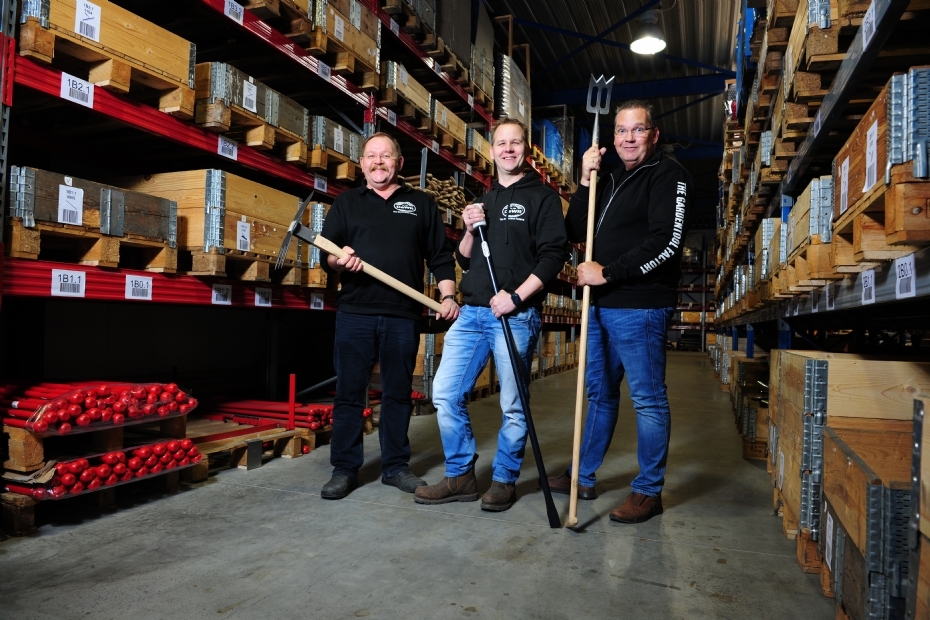DeWit Expands Successful Cultivator Series with the Combi Cultivator |
|
|
|
|
 |
| 125 sec |
'Work more efficiently without switching tools'
A quarter of a century ago, DeWit produced its first cultivator. What started as a solid piece of hand tool for soil cultivation has grown into a complete series of 22 different models over the years. Recently, DeWit expanded its cultivator line with a striking new tool: the Combi Cultivator. This smart tool responds to the need of landscapers to work more efficiently without constantly changing tools.
A cultivator is a versatile tool commonly used by gardeners and landscapers. Loosening the soil is perhaps its most familiar application. However, it's also highly effective for incorporating compost, fertilizers or soil improvers. Unlike a rake, a cultivator works with longer tines, allowing deeper and more targeted soil treatment without disturbing the structure. On the Combi Cultivator, DeWit has added a hoe and chopping blade above the tines.
Complete tasks in one smooth motion
While cultivating, switching becomes effortless: encounter a stubborn weed, and you simply rotate the tool half a turn to use the hoe blade and remove it immediately. This avoids the extra walk to fetch a separate hoe and allows you to finish the job in one fluid motion. The garden or border is left loosened and weed-free exactly the way professionals aim to deliver it to clients. The Combi Cultivator is now available in several versions, so landscapers can choose the one that best suits their working style.
Product range continues to grow
The cultivator line has expanded significantly over the decades, always developed in close collaboration with end users. 'That practical focus is part of our DNA,' says director Sietse de Wit. 'We don't design from a drawing board, but from the garden, the place where the tools are actually used.' Since no two gardens are alike, DeWit offers a broad and well thought out range of more than 25 cultivators. 'We have the right model for every gardener and every task,' says De Wit.
|
|
'Every landscaper has their own preference for posture, grip and technique. At DeWit, we take that into account.'
| |
|
'Our assortment ranges from short models with 14 or 25 cm handles, ideal for precision work and hard-to-reach spots, to cultivators with 48 cm shafts that are comfortable to use at knee height. For larger gardens or prolonged tasks, we offer long handles of 1400, 1500 or even 1700 mm, enabling upright, ergonomic work. Whether you prefer control, power or speed, we always have a cultivator that fits your working method.'
Cultivator essential for soil preparation
Where a rake is mainly used for gathering loose material or levelling, a cultivator digs deeper. Its longer tines are designed to loosen and aerate the upper soil layer—essential for improving soil structure and enabling water, air and nutrients to reach plant roots. For preparing borders, planting beds or vegetable gardens, a cultivator ensures the soil is ready for planting or sowing. It's also ideal for mixing in compost or manure. Weed removal becomes easier too, without having to turn over the entire soil. For green professionals who aim to work efficiently and with care, a cultivator clearly offers more than a standard rake.
|
 | | Derk de Wit, Derk Klaas de Wit and Sietse de Wit |
|
|
The cultivator shows its teeth
The number of tines largely determines the precision and scale of a cultivator's use. A single-tine model is ideal for detail work—between perennials, around roots, or in narrow borders where careful maneuvering is required. The three-tine model is the all-rounder most landscapers work with: wide enough to work quickly on mid-sized areas, yet compact enough for most planting beds and borders. The five-tine version is designed for larger-scale tasks: wide borders, vegetable plots or areas where speed is important. Its broader working width covers more ground in one motion, saving time during repetitive maintenance or prep work. In short: fewer tines means more precision, more tines means more coverage.
|
| LOG IN
with your email address to respond.
|
|
|
| There are no comments yet. |
|
| |
Anyone can place small ads for free through their own account.
Place a free ad
|
|
|
|